And as the Tracks Run Over the Green Hills of Ireland Were Sure to Do It Again
Rules for pedestrians (1 to 35)
The Highway Lawmaking for Northern Ireland's rules for pedestrians.
General guidance
one
Footways or footpaths (including any path along the side of a road) should be used if provided. Where possible, avoid existence adjacent to the kerb with your dorsum to the traffic. If you accept to step into the route, look both means outset. Always bear witness due intendance and consideration for others.
two
If there is no footway or footpath, walk on the right-manus side of the road so you can encounter oncoming traffic. You should take actress intendance and:
- be prepared to walk in single file, especially on narrow roads or in poor lite
- continue close to the side of the road
It may be safer to cross the road well before a sharp right-hand curve so that oncoming traffic has a better take chances of seeing you. Cross back after the bend.
three
Help other road users to run into you. Clothing or carry something low-cal-coloured, bright or fluorescent in poor daylight conditions. When it is dark, employ reflective materials (for example; armbands, sashes, waistcoats, jackets, footwear), which tin be seen by drivers using headlights upward to iii times every bit far abroad as non-reflective materials.
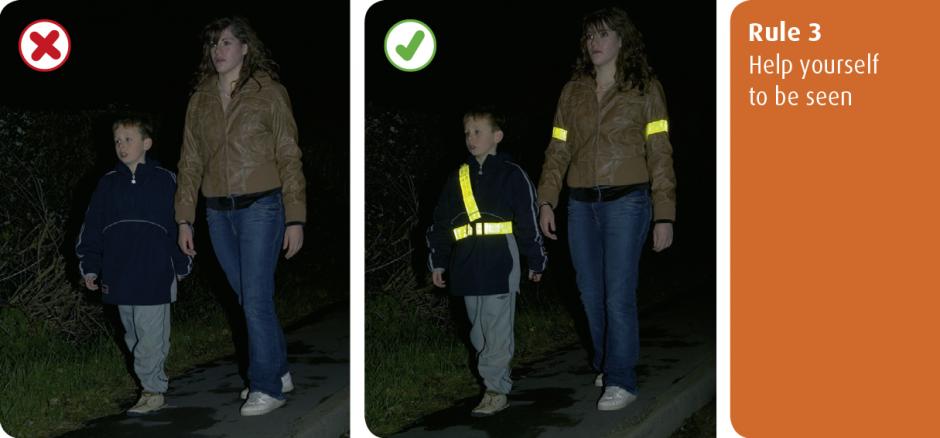
four
Young children should not be out solitary on the footway, footpath or road (see Rule 7). When taking children out, go along between them and the traffic and hold their hands firmly. Strap very young children into push-chairs or use reins. When pushing a young child in a buggy, do not push the buggy into the road when checking to see if it is clear to cross, especially from between parked vehicles.
5. Organised walks
Big groups of people walking together should employ a footway or footpath if bachelor; if one is not, they should go along to the left. Look-outs should exist positioned at the front and back of the group and they should wear fluorescent clothes in daylight and cogitating clothes in the dark. At night the look-out in front should prove a white light and the i at the back a red lite. People on the outside of large groups should besides carry lights and wear reflective clothing.
vi. Motorways
Pedestrians must not exist on motorways or slip roads except in an emergency (meet rules 271 and 275).
Laws RO Art 20 & MTR reg 13(one)(b)
- Motorways (253 to 273)
- Breakdowns and incidents (274 to 287)
Crossing the road
vii. The Green Cross Code
The advice given below for crossing the route is for all pedestrians. Children should be taught the Code and should non exist allowed out alone until they can understand and use it properly. The age when they tin can exercise this is different for each child.
Many children cannot judge how fast vehicles are going or how far away they are. Children acquire by example, so parents and carers should e'er utilize the Code in full when out with their children. They are responsible for deciding at what age children can use it safely by themselves.
A
First find a safe place to cross and where at that place is a space to accomplish the footway or footpath on the other side. Where there is a crossing nearby, utilize it. It is safer to cross using a subway, a footbridge, an island, a zebra, pelican, toucan or puffin crossing, or where in that location is a crossing point controlled past a police officer or school crossing patrol. Otherwise choose a place where you tin see conspicuously in all directions.
Try to avert crossing betwixt parked cars (see Dominion 14), on a blind curve or close to the brow of a colina. Move to a space where drivers and riders tin see you clearly. Practice not cross the road diagonally.
B
Stop merely earlier y'all become to the kerb, where you can come across if anything is coming. Practise not get too close to the traffic. If there's no footway or footpath keep back from the edge of the road simply make sure you can still see approaching traffic.
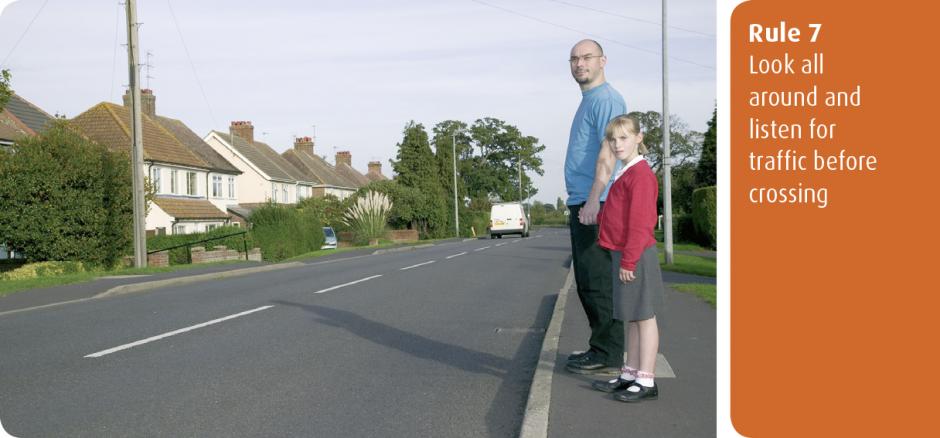
C
Look all around for traffic and mind. Traffic could come from whatever direction. Listen every bit well, because you can sometimes hear traffic before you lot see it.
D
If traffic is coming, allow it pass. Look all around again and heed. Practice non cross until there is a safe gap in the traffic and yous are certain that there is plenty of time. Remember, even if traffic is a long fashion off, it may be budgeted very quickly.
E
When it is safe go straight across the road – practise non run. Keep looking and listening for traffic while you cross, in case there is any traffic you did not see, or in case other traffic appears all of a sudden. Look out for cyclists and motorcyclists travelling between lanes of traffic. Do not walk diagonally across the route.
eight. At a junction
When crossing the road, await out for traffic turning into the road, specially from behind y'all. If you take started and traffic wants to turn into the road, you have priority and they should requite way (see rule 170).
- Highway Code rules 159 to 203
9. Pedestrian safe barriers
Where there are barriers, cantankerous the route merely at the gaps provided for pedestrians. Do not climb over the barriers or walk between them and the route.
10. Tactile paving
Raised surfaces that tin be felt underfoot provide alert and guidance to blind or partially sighted people. The almost common surfaces are a serial of raised studs, which are used at crossing points with a dropped kerb, or a series of rounded raised bars which are used at level crossings, at the elevation and lesser of steps and at some other hazards.
11. One-way streets
Check which style the traffic is moving. Practice not cross until information technology is safe to practise so without stopping. Bus and cycle lanes may operate in the opposite management to the residual of the traffic.
12. Bus and cycle lanes
Take care when crossing these lanes equally traffic may be moving faster than in other lanes, or against the period of traffic.
thirteen. Routes shared with cyclists
Some bike tracks run aslope footways or footpaths, using a segregating feature to separate cyclists from people on human foot. Segregated routes may also incorporate curt lengths of tactile paving to help visually impaired people stay on the correct side. On the pedestrian side this will contain a serial of flat-topped confined running across the direction of travel (ladder blueprint). On the cyclist side the same bars are orientated in the management of travel (tramline pattern). Not all routes which are shared with cyclists are segregated. Take extra care where this is and so (see dominion 62).
- Rules for cyclists (59 to 82)
fourteen. Parked vehicles
If you have to cross between parked vehicles, employ the outside edges of the vehicles as if they were the kerb. Stop there and brand certain you tin see all effectually and make sure the traffic can see you lot. Make sure in that location is a gap between any parked vehicles on the other side then you tin can reach the footway or footpath. Never cross the road in front of, or backside, any vehicle with its engine running, especially a large vehicle, as the driver may not exist able to run into you.
15. Reversing vehicles
Never cross behind a vehicle that is reversing, showing white reversing lights or sounding a warning.
16. Moving vehicles
Yous must not go on to or hold on to a moving vehicle.
Law RTO 1995 Art 37
17. At night
Wear something reflective to make it easier for others to encounter you lot (come across Rule three). If there is no pedestrian crossing nearby, cross the route well-nigh a street lite and then that traffic can run into you more than easily.
Crossings
18. At all crossings
When using whatsoever type of crossing you should:
- always cheque that the traffic has stopped before you lot start to cantankerous or push a pram onto the crossing
- e'er cantankerous between the studs or over the zebra markings, practise not cantankerous at the side of the crossing or on the zigzag lines, as information technology can be unsafe
You must not loiter on whatsoever blazon of crossing.
Laws RTRO Art 59(4) & PCR reg 17
xix. Zebra crossings
Give traffic plenty of time to meet you and to stop before you cross. Vehicles will need more time when the road is slippery. Wait until traffic has stopped from both directions or the road is clear before crossing. Think that traffic does not take to end until someone has moved onto the crossing. Keep looking both ways, and listening, in case a driver or rider has non seen y'all and attempts to overtake a vehicle that has stopped.
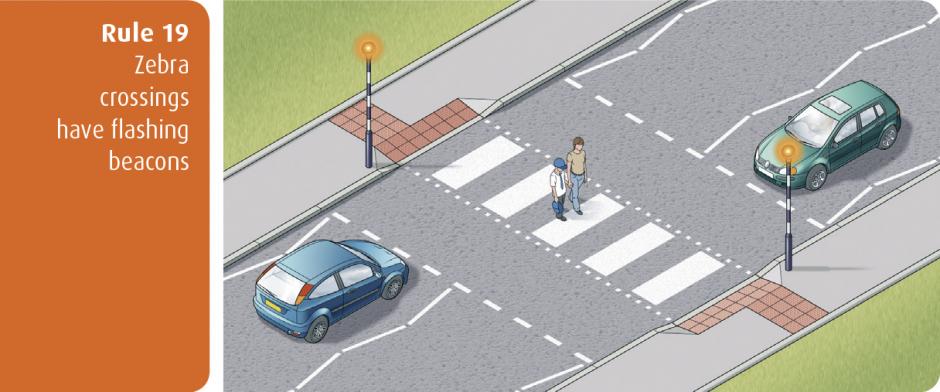
20
Where there is an island in the middle of a zebra crossing, wait on the island and follow Rule 19 earlier you lot cantankerous the 2nd half of the road – it is a divide crossing.
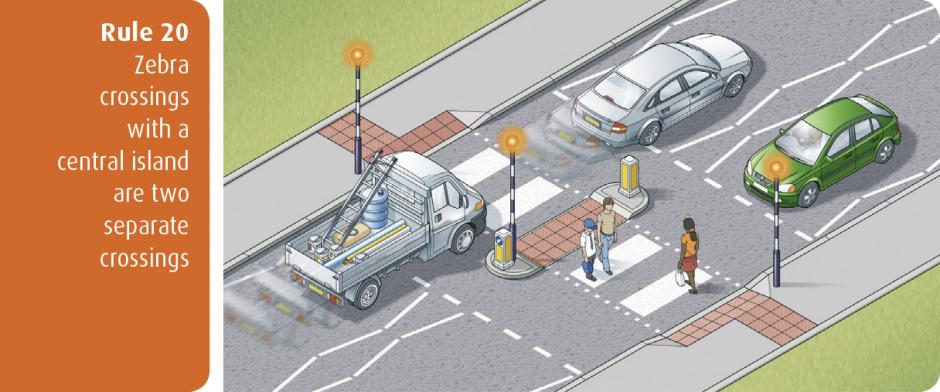
21. At traffic lights
There may be special signals for pedestrians. You should simply start to cross the road when the dark-green effigy shows. If you lot have started to cross the road and the green effigy goes out, you should still have time to accomplish the other side, only do not delay.
If no pedestrian signals have been provided, scout carefully and do not cross until the traffic lights are cherry and the traffic has stopped. Keep looking and cheque for traffic that may be turning the corner. Remember that traffic lights may let traffic move in some lanes while traffic in other lanes has stopped.
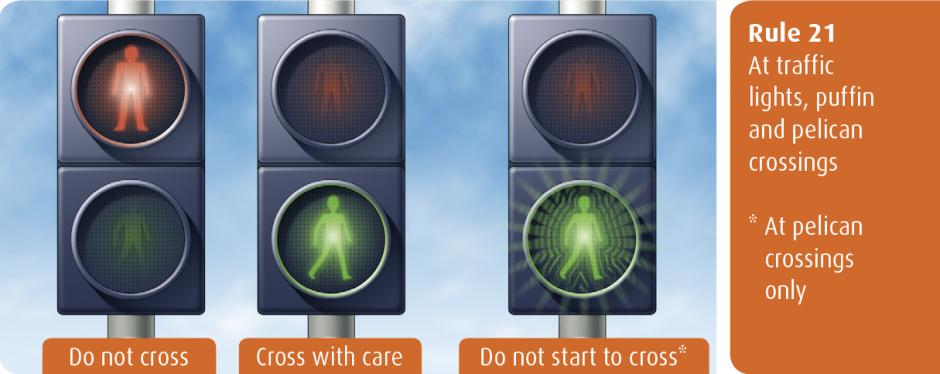
22. Pelican crossings
These are signal-controlled crossings operated by pedestrians. Push the control button to activate the traffic signals. When the ruby-red figure shows, exercise not cross. When a steady green figure shows, check that traffic has stopped and then cantankerous with care. When the green effigy begins to flash you should not cantankerous. If you have already started you lot should accept time to stop crossing safely.
23
Puffin crossings differ from pelican crossings as the scarlet and light-green figures are above the control box on your side of the road and there is no flashing green figure phase. Press the button and wait for the dark-green effigy to show.
24
When the road is congested, traffic on your side of the road may be forced to cease even though their lights are green. Traffic may still be moving on the other side of the road, so printing the push button and wait for the signal to cross.
25
Toucan crossings are light-controlled crossings which allow cyclists and pedestrians to share crossing infinite and cantankerous at the aforementioned time. They are push-push operated. Cyclists are permitted to ride across.
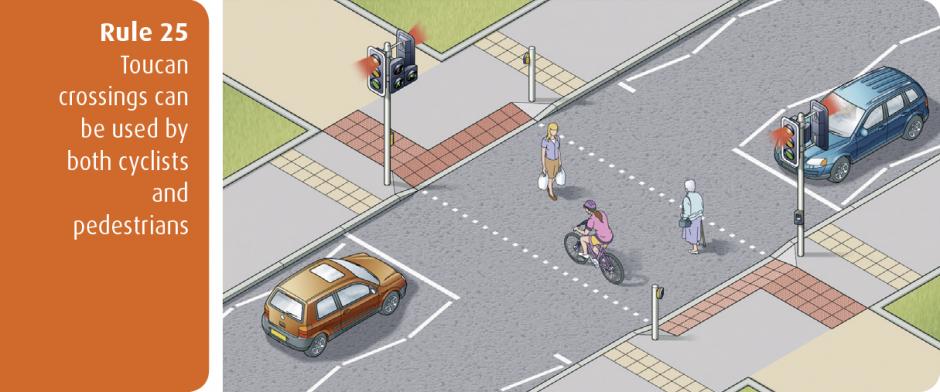
26
At some crossings at that place is a bleeping sound or voice signal to signal to bullheaded or partially sighted people when the steady green figure is showing, and there may be a tactile signal to help deafened blind people.
27
Equestrian crossings are for horse riders. They have pavement barriers, wider crossing spaces, horse and rider figures in the lite panels and either ii sets of controls (ane higher), or just one higher control console.
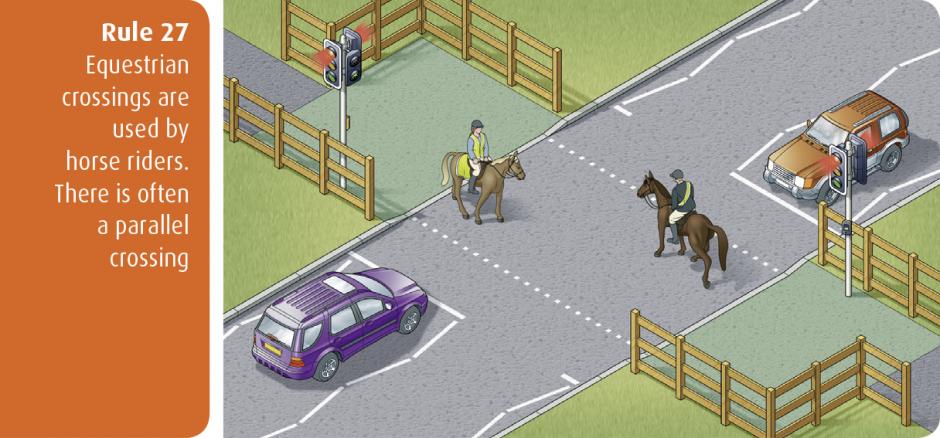
28. 'Staggered' pelican or puffin crossings
When the crossings on each side of the key refuge are not in line they are ii split crossings. On reaching the central island press the push again and look for a steady green figure.
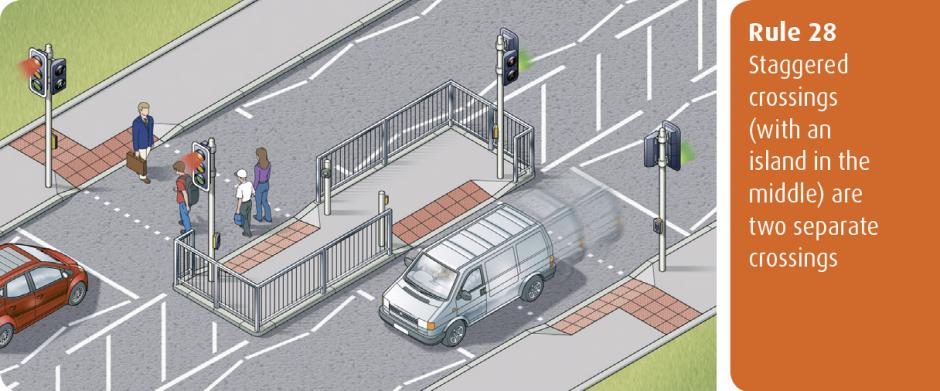
29. Crossings controlled by an authorised person
Do not cantankerous the route unless y'all are signalled to do so past a police officer or schoolhouse crossing patrol. Always cantankerous in front end of them.
30
Where there are no controlled crossing points available information technology is appropriate to cross where there is an island in the middle of the road. Use the Green Cantankerous Code (see Rule seven) to cross to the island then stop and use it again to cross the 2d half of the road.
Situations needing extra intendance
31. Emergency vehicles
If an ambulance, fire engine, constabulary or any other emergency vehicle approaches using flashing blue lights, headlights and/or sirens, keep off the road.
32. Buses
Get on or off a bus only when information technology has stopped to allow you lot to do so. Watch out for cyclists when yous are getting off. Never cantankerous the road directly behind or in forepart of a bus. Wait until information technology has moved off and you can see the route conspicuously in both directions.
33. Tramways
These may run through pedestrian areas. Their path will exist marked out past shallow kerbs, changes in the paving or other route surface, white lines or yellow dots. Cross at designated crossings where provided. Elsewhere treat trams as you would other vehicles and look both ways forth the rail before crossing. Practise not walk forth the rail as trams may come up behind you. Trams movement quietly and cannot steer to avoid yous.
34. Railway level crossings
Yous must not cross or pass a terminate line when the scarlet lights show, (including a ruddy pedestrian figure). Also practise not cross if an alert is sounding or the barriers are being lowered. The tone of the alarm may change if another train is approaching. If at that place are no lights, alarms or barriers, stop, look both ways and heed before crossing.
A tactile surface comprising rounded bars running across the management of pedestrian travel may be installed on the footway or footpath approaching a level crossing to warn visually impaired people of its presence. The tactile surface should extend across the total width of the footway or footpath and should be located at an appropriate distance from the barrier or projected line of the barrier.
Police TSR reg 39
35. Street, footway and footpath repairs
A footway or footpath may be closed temporarily because it is not safety to use. Accept actress care if you are directed to walk on or to cross the road.
More than useful links
- Pedestrians - Road Prophylactic Education leaflet
- Be Safe Be Seen - Road Safety Education leaflet
- The Highway Code - downloadable version
williamslande1963.blogspot.com
Source: https://www.nidirect.gov.uk/articles/rules-pedestrians-1-35
0 Response to "And as the Tracks Run Over the Green Hills of Ireland Were Sure to Do It Again"
Post a Comment